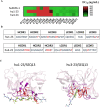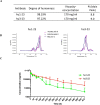Novel monkey mAbs induced by a therapeutic vaccine targeting the hepatitis B surface antigen effectively suppress hepatitis B virus in mice
- PMID: 34646979
- PMCID: PMC8499627
- DOI: 10.1093/abt/tbab020
Novel monkey mAbs induced by a therapeutic vaccine targeting the hepatitis B surface antigen effectively suppress hepatitis B virus in mice
Abstract
Background: We have previously obtained a mouse anti-hepatitis B surface antigen (HBsAg) antibody E6F6 with long-lasting serum HBsAg clearance effects. The E6F6 epitope-based protein CR-T3-SEQ13 (HBsAg aa 113-135) vaccination therapy in cynomolgus monkeys induced long-term polyclonal antibodies-mediated clearance of HBsAg in the HBV transgenic (HBV-Tg) mice.
Methods: We isolated monoclonal antibodies from CR-T3-SEQ13 vaccinated cynomolgus monkeys, compared their therapeutic effects with E6F6, identified their epitopes on HBsAg, determined the pharmacokinetics and studied their physical property.
Results: A panel of anti-HBsAg mAbs was generated through memory B cell stimulatory culture. Two lead monkey-human chimeric antibodies, C1-23 and C3-23, effectively suppressed HBsAg and HBV DNA in HBV-Tg mice. The humanized antibodies and humanized-mouse reverse chimeric antibodies of two antibodies exhibited comparable HBsAg clearance and viral suppression efficacy as those versions of E6F6 in HBV-Tg mice. Humanized antibody hu1-23 exhibited more efficacy HBsAg-suppressing effects than huE6F6-1 and hu3-23 in HBV-Tg mice at dose levels of 10 and 20 mg/kg. Evaluation of the binding sites indicates that the epitope recognized by hu1-23 is located in HBsAg aa 118-125 and 121-125 for hu3-23. Physical property study revealed that hu1-23 and hu3-23 are stable enough for further development as a drug candidate.
Conclusions: Our data suggest that the CR-T3-SEQ13 protein is a promising HBV therapeutic vaccine candidate, and hu1-23 and hu3-23 are therapeutic candidates for the treatment of chronic hepatitis b. Moreover, the generation of antibodies from the epitope-based vaccinated subjects may be an alternative approach for novel antibody drug discovery.
Keywords: B cell culture; antibody-mediated HBV suppression; chronic hepatitis B infection; cynomolgus monkey antibody; hepatitis B surface antigen.
© The Author(s) 2021. Published by Oxford University Press on behalf of Antibody Therapeutics.
Figures





References
-
- Schweitzer, A, Horn, J, Mikolajczyk, RT et al. Estimations of worldwide prevalence of chronic hepatitis B virus infection: a systematic review of data published between 1965 and 2013. Lancet 2015; 386: 1546–55. - PubMed
-
- Migone, TS, Subramanian, GM, Zhong, J et al. Raxibacumab for the treatment of inhalational anthrax. N Engl J Med 2009; 361: 135–44. - PubMed
-
- Malley, R, DeVincenzo, J, Ramilo, O et al. Reduction of respiratory syncytial virus (RSV) in tracheal aspirates in intubated infants by use of humanized monoclonal antibody to RSV F protein. J Infect Dis 1998; 178: 1555–61. - PubMed
LinkOut - more resources
Full Text Sources
Molecular Biology Databases
Miscellaneous
